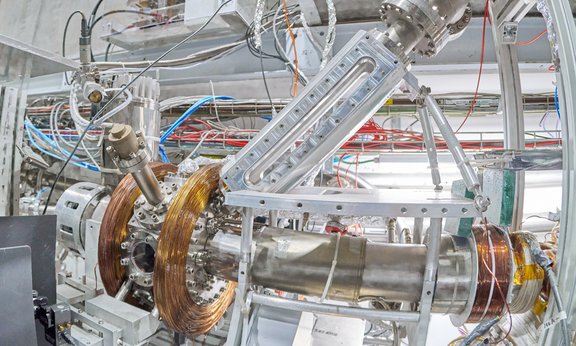Positronium is an exotic atom consisting of an electron and its anti-particle, a positron. Scientist from the AEgIS-Kollaboration at CERN now were able to substantially reduce the temperature of a positronium cloud from 380 K to 170 K. The key to this success was the development of a broadband laser system at 243 nm able to saturate the 1S–2P triplet transition of positronium. Therefore, Giovanni Cerchiari from the Department of Experimental Physics at the University of Innsbruck set up and maintained the probing laser for positronium spectroscopy. “This is the first-ever demonstration of laser cooling of this exotic matter-antimatter system and so, in general, of an atom composed only of leptonic matter”, says Cerchiari. The AEgIS collaboration will utilize taser-cooled positronium as a precursor for the formation of antihydrogen atoms, the antimatter counterpart of hydrogen. By utilizing laser-cooled positronium, the experiment will increase the yield of production of antihydrogen that is then used for the precision measurement of the free fall of antimatter in the gravitation field of Earth. This measurement will push new limits in testing the equivalence principle of general relativity for antimatter which might reveal the asymmetry between matter and antimatter.
The accomplishment's significance impacts multiple physics domains, potentially establishing a foundation for forthcoming experiments and technological advancements. “A few examples are examining fundamental physics beyond the confines of the Standard Model of particle physics, investigating the potential implementation of a gamma-ray laser to analyze Bose-Einstein condensates with antimatter, testing the Equivalence Principle of gravitation with antimatter in a purely leptonic system, and utilizing the sensitivity of positronium annihilation to probe the microscopic properties of materials”, says Giovanni Cerchiari.
The work published now in Physical Review Letters provides a comprehensive analysis of the experiment and its ramifications. A Japanese colleague's analogous investigation will lay a fresh groundwork for subsequent developments in the field of physics research.
Publikationen:
Positronium laser cooling via the 13S-23P transition with a broadband laser pulse. L. T. Glöggler et al. Phy. Rev. Lett. 2024 DOI:
10.1103/PhysRevLett.132.083402, arXiv:2310.08760
Laser cooling of positronium. K. Shu et al. arXiv:2310.08761

